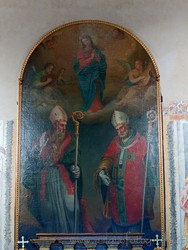|
Montevecchia (Lecco, Italy): Church of San Bernardo
|
|
|
Show an other place around Milan worth a visit: |
 The Small Church of San Bernardo is a small oratory in the homonymous locality of Montevecchia, on the panoramic road. The Small Church of San Bernardo is a small oratory in the homonymous locality of Montevecchia, on the panoramic road.
HISTORY
The construction of the Oratory of S. Bernardo probably took place in two stages.
In the early decades of the sixteenth century, a small chapel was initially built.
It was then enlarged at the end of the century through the addition of the nave, the sacristy and a small bell tower and the transformation of the original chapel into the presbytery of the oratory.
The expansion was carried out on behalf of Giovanni Antonio Scaccabarozzi, a native of Montevecchia, but residing in Milan and canon of the church (no longer existing) of Santa Maria alla Scala.
Tombstones inside the oratory testify that the oratory was consecrated by Archbishop Gaspare Visconti on August 20, 1593.
The church underwent several changes of ownership over the centuries, until in 1914 it became the property of the parish.
In the period between 1994 and 2000 the small church underwent a profound restoration, which allowed, among other things, to back bring to light the frescoes on the walls and previously hidden by past whitewashings.
STRUCTURE
The oratory has a very simple structure. It comprehends the main hall, the rectangular apse (the oldest part of the small church and, as mentioned, originally an autonomous chapel), a small sacristy, leaning against the left side of the apse, and a small bell tower, nestled between the right side of the oratory and the former rectory leaning against the right side of the church.
Externally the church is devoid of decorations. The gabled façade houses the central door and a large rectangular window above it.
The interior, with a barrel roof in the nave and a Lombard variegated floor, is much richer in decorations.
First of all there is an elegant terracotta frame that runs along all the walls, stopping only at the counter-façade cantoria (unfortunately almost completely no longer original but redone during the last restorations) and at the niche on the back wall of the apse in which the altarpiece is located.
The walls are entirely occupied (except in the counter-façade) by late Renaissance Luini school frescoes created at the end of the sixteenth century and depicting almost full-sized figures of saints. Each figure is placed within a frame of geometric decorative elements, in turn separated by trompe l'oeil columns.
The two figures on the sides of the altar, which seem to have been painted by Andrea Appiani at the end of the eighteenth century, would make an exception.
On the left wall (Fig. 4), starting from the entrance, you have:
- Santa Margherita represented together with the dragon.
- The upper part of a panel whose subject cannot be deciphered. The lower part was already lost in the past due to the creation of a door towar the small cemetery that once stood against the left side of the church.
- San Giacomo Maggiore depicted with the pilgrim's stick with the hat hanging on it.
- (on the left side of the arch that surrounds the opening of the apse) Sant'Antonio Abate.
On the right wall, always starting from the entrance, you have instead:
- Saint Jerome penitent in the desert in front of the crucifix (Fig. 5 right), in the act of beating his chest with a stone.
- Saint Francis on the mount Verna, while receiving the stigmata (Fig. 5 left).
- An empty panel that until the last restorations housed a remake of 1945 depicting Sant'Eugenia. The fresco was detached during the restoration and is now kept in the meeting house of the Sanctuary of the Blessed Virgin of Carmel.
- (on the right side of the arch that surrounds the opening of the apse) Saint Catherine of Alexandria with the palm of martyrdom and the wheel.
The two figures on the sides of the altar, attributed to Andrea Appiani, are instead St. John Baptist (on the left) and Saint Peter, with the keys of paradise.
The altar, in carved and gilded wood, houses four ancient display cases, also in carved and gilded wood, containing ancient relics of five different saints. They were brought from Rome by Canon Scaccabarozzi in the sixteenth century.
On the back wall of the presbytery there is the altarpiece in oil perfectly inserted in a large niche (larger picture) and probably painted between the sixteenth and seventeenth centuries. In it are depicted below Saint Bernard and Saint Ambrose and, above, the Virgin of the Assumption. The author (or perhaps the authors, because the two saints and the Virgin seem to have been painted by different hands) are unknown.
The oratory houses the burial of the Canon Scaccabarozzi, located in the corridor near the presbytery. It is recognizable by a beautiful tombstone in which the family coat of arms the and dedication are surrounded by a renaissance grotesque frame.
The Oratory of San Bernardo is usually open on the afternoon of public holidays.
Categories: Places of historical value of artistic value
Via Belvedere, 49, 23874 Montevecchia LC |
Further pictures of Church of San Bernardo in the section Photography |